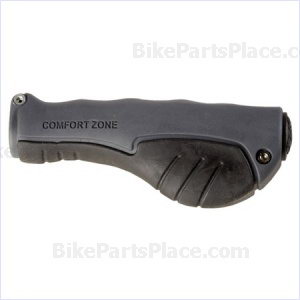
- Grips are available in many different materials and shapes
- Hybrid bikes feature less aggressive grips, while mountain bikes have more aggressive grips
- The newest trend in grips is specially shaped designs made for comfort and efficiency
From the old white Schwinn handlebar grips to the ultra-light carbon-composite grips of today, there’s no doubt that the handlebar is one of the most important parts of the bike.
Since it’s one of three places at which your body directly interacts with the bike, it’s important to have handlebar grips that feel good in your hands.
For all but the least-picky riders, choosing the right shape and texture is of the utmost priority. And there are many, many, many choices.
Removable grips are most commonly associated with mountain, BMX and hybrid bikes, since road bike handlebars are typically wrapped with bar tape. Most of the grips that come standard on such bikes feature a light texture in some cases (hybrids) and a heavier grip pattern in others (mountain bikes).
Hybrid grips are traditionally the least-aggressive. On high-end bikes, the grip is sometimes made of smooth leather or a soft, yet firm, rubber. Because they often feature SRAM Grip Shifters, some hybrids might not be able to accept aftermarket or third-party grips. As hybrids are generally ridden less aggressively, they don’t necessarily need grip-enhancing patterns.
The nature of BMX bikes dictates the need for a good, solid grip. Often, the grip has deep patterns or ridges, and is made of harder, more durable rubber. There are often large rubber rings on the inside edge of each grip, in order to keep the rider’s hands in place on jumps.
Mountain bike grips are changing rapidly, thanks to an increase in ridership. From the recreational rider to the cross-country racer to the 24-hour endurance racer, there have never been more different styles of mountain biking.
The range of grips changes according to the type of riding, too. For recreational riders, standard grips are likely good enough. Made of firm rubber with a medium grip pattern, they’ll be comfortable enough for most riding.
Most often, upgrades to the standard grip push it toward a softer rubber, which helps cushion the blow of rugged off-road terrain. Yeti and Oury make upgraded grips that contain silicone rubber, a soft, durable compound.
One of the latest trends toward grips is making them in special ergonomic shapes. Traditional grips are merely sleeves over a round bar, meaning the pressure of the bar is distributed in a straight line across the palm.
Ergonomic shapes have a paddle-like design that helps distribute a rider’s weight across the palm. German company Ergon is one of the pioneers in the field, bringing almost a dozen different shapes to the market. Ergon grips are made of plastic, resin or carbon fiber, and have soft or firm grip surfaces.
Depending upon your riding style and hand/wrist conditioning, you may need to tweak your grips a little bit. Most often, those who suffer from frequent soreness could benefit from a contoured or ergonomic design.
Tags: handlebar grips


 Shopping
Shopping



Hand comfort is important whether you’re racing, marathoning, or just tooling around. There’s a lot of constant stress on your hands, and a hard, unforgiving grip will take its toll. I just ordered a pair of Ergon MTB’s. A little pricey, but I think the palm support will be just what I was looking for. The outside of the butt of my hand is still the sorest spot on my body after a ride of any length. I’ll let you know.
Oh my goodness! Amazing article dude! Thank you so much, However I am going through troubles with your RSS.
I don’t know the reason why I am unable to subscribe to it.
Is there anybody else getting similar RSS problems? Anyone that knows the solution will you
kindly respond? Thanx!!